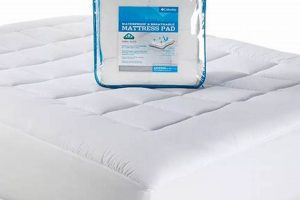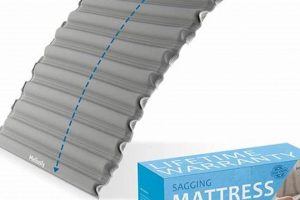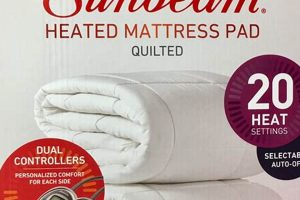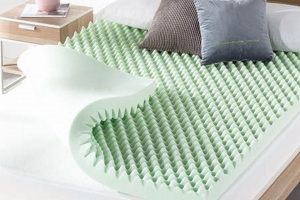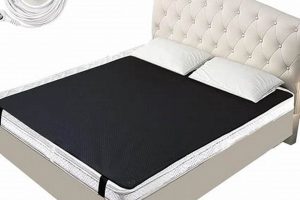A do-it-yourself bedding layer crafted to enhance comfort or protect the underlying sleep surface involves using materials and techniques readily accessible to the average individual. Examples range from simple quilted covers made from repurposed fabrics to more complex designs incorporating specialized materials for temperature regulation or pressure relief.
Creating a custom bedding layer offers advantages such as cost savings, personalized comfort, and the ability to tailor materials to specific needs, including allergies or sensitivities. Historically, homemade bedding was commonplace, reflecting resourcefulness and the desire for customized comfort before mass-produced options became widely available. The resurgence of such practices reflects a renewed interest in sustainability and individualized home solutions.
The following sections will delve into specific material choices, construction methods, and design considerations for creating a bedding layer that meets individual needs and preferences, addressing both basic and advanced techniques.
Essential Considerations for Constructing a Custom Bedding Layer
The creation of a custom bedding layer requires careful planning and execution to achieve optimal comfort and durability. The following tips outline key considerations for a successful project.
Tip 1: Material Selection: The choice of materials significantly impacts the performance of the bedding layer. Natural fibers, such as cotton or wool, offer breathability and moisture-wicking properties. Synthetic options like memory foam provide pressure relief but may retain heat. Consider individual comfort preferences and any allergy sensitivities when making selections.
Tip 2: Dimensional Accuracy: Precise measurements of the underlying mattress are critical for ensuring a proper fit. An ill-fitting bedding layer can bunch, shift, or fail to provide adequate coverage. Add extra fabric to account for seam allowances and potential shrinkage during washing.
Tip 3: Stitching Technique: Employ secure and durable stitching methods to prevent seams from unraveling. A straight stitch with a reinforced backstitch at the beginning and end is generally recommended. Consider using a serger for finishing raw edges to prevent fraying.
Tip 4: Layering Strategy: Multiple layers can enhance comfort and functionality. A thin layer of batting can provide cushioning, while a waterproof membrane can protect the mattress from spills. Plan the order and thickness of layers based on desired outcomes.
Tip 5: Securing Mechanisms: Implement methods for securing the bedding layer to the mattress to prevent shifting. Elastic straps, fitted sheets, or corner anchors can provide stability. Consider the ease of removal for cleaning when choosing a securing mechanism.
Tip 6: Hygiene Maintenance: Select materials that are easy to clean and maintain. Washable fabrics are preferable, and the use of mattress protectors can further extend the lifespan of the bedding layer. Regularly launder the item according to manufacturer instructions to prevent the buildup of allergens and dust mites.
Tip 7: Density and Support: For individuals seeking added support, higher-density foams or quilted construction can offer enhanced firmness. Consider the existing firmness of the mattress and adjust the layer’s construction accordingly to achieve the desired level of support.
Careful attention to these considerations will result in a custom bedding layer that enhances sleep quality and prolongs the lifespan of the mattress.
The subsequent sections will explore specific construction techniques and address common challenges encountered during the creation of a custom bedding layer.
1. Material breathability
Material breathability is a paramount consideration when constructing a do-it-yourself bedding layer. The inherent ability of a material to allow air and moisture vapor to pass through its structure directly impacts sleep comfort, temperature regulation, and overall hygiene.
- Thermoregulation and Comfort
Breathable materials facilitate the dissipation of body heat, preventing overheating during sleep. Fabrics like cotton, linen, and wool promote airflow, wicking away moisture and maintaining a comfortable sleeping temperature. Conversely, non-breathable materials, such as vinyl or certain synthetic foams, can trap heat and moisture, leading to discomfort and potential skin irritation.
- Moisture Management and Hygiene
The breathability of materials directly affects moisture management within the bedding layer. Fabrics that allow moisture to evaporate prevent the accumulation of sweat and humidity, inhibiting the growth of bacteria and mold. This reduces the risk of unpleasant odors and allergens, promoting a healthier sleep environment. Closed-cell foams, lacking breathability, can create a breeding ground for microbes in humid conditions.
- Material Structure and Airflow
The weave and structure of a fabric influence its breathability. Loosely woven materials, such as muslin or open-weave knits, offer superior airflow compared to tightly woven fabrics. The presence of pores or channels within the material’s structure allows for greater air circulation. This principle is particularly relevant when selecting batting or filler materials for the bedding layer, where density and structure can impact overall breathability.
- Impact on Mattress Longevity
Breathability also plays a role in the longevity of the underlying mattress. By allowing moisture to escape, a breathable bedding layer prevents the buildup of humidity within the mattress, reducing the risk of mold growth and material degradation. This extends the lifespan of the mattress and maintains its structural integrity over time.
The selection of breathable materials is, therefore, an integral component of the creation process. Choosing appropriate fabrics and fillers not only enhances sleep comfort but also contributes to a healthier and more hygienic sleep environment, prolonging the lifespan of both the bedding layer and the underlying mattress. Failure to prioritize breathability can compromise these benefits and lead to discomfort, hygiene issues, and premature deterioration of materials.
2. Seam Durability
Seam durability represents a critical performance aspect of a custom bedding layer, directly affecting its longevity and overall functionality. Inadequate seam strength leads to premature failure, undermining the benefits of material selection and construction efforts. Attention to seam integrity is, therefore, essential.
- Thread Selection and Compatibility
The type of thread used significantly impacts seam strength. Polyester or nylon threads generally exhibit superior tensile
strength and resistance to abrasion compared to cotton threads. It is important to select a thread compatible with the chosen fabric; heavier fabrics require heavier threads to ensure adequate seam strength. Using a thread that is too weak for the fabric can result in seam slippage and eventual failure. - Stitch Type and Density
The stitch type influences the strength and elasticity of the seam. A straight stitch is adequate for lightweight fabrics, while a reinforced stitch, such as a zigzag or triple stitch, provides greater durability for heavier materials. Stitch density, measured as stitches per inch, is also a crucial factor. Higher stitch density generally increases seam strength, but excessive density can weaken the fabric. A balance between stitch type and density is necessary to achieve optimal seam durability.
- Seam Allowance and Construction Method
The width of the seam allowance impacts seam strength and resistance to fraying. A wider seam allowance provides more fabric for the stitches to grip, reducing the likelihood of seam slippage. Proper seam construction techniques, such as serging or using a French seam, can further enhance durability by preventing raw edges from unraveling. These techniques are particularly important for fabrics prone to fraying.
- Stress Points and Reinforcement
Certain areas of a bedding layer, such as corners and edges, are subject to increased stress. Reinforcing these areas with additional stitching or using specialized seam finishes can prevent premature failure. Applying fusible interfacing to stress points can also provide additional support and prevent fabric distortion. Identifying and reinforcing these areas is essential for ensuring the long-term durability of the bedding layer.
In summary, seam durability is not merely an aesthetic consideration but a fundamental aspect of its construction. The selection of appropriate threads, stitch types, and seam construction methods, combined with reinforcement of stress points, will contribute significantly to the longevity and performance of the custom bedding layer. Neglecting these factors will inevitably result in premature seam failure and reduced product lifespan.
3. Dimensional accuracy
Dimensional accuracy is paramount in the construction of a do-it-yourself mattress pad. Inaccurate measurements directly compromise the fit, comfort, and overall functionality of the finished product. The cause-and-effect relationship is straightforward: imprecise dimensions lead to a pad that is either too small, leaving portions of the mattress unprotected, or too large, resulting in bunching, shifting, and discomfort. A real-life example involves attempting to create a fitted mattress pad using measurements that fail to account for mattress depth; the resulting pad will not stay in place, negating its intended purpose.
Achieving dimensional accuracy necessitates meticulous measurement techniques. Length, width, and depth (or thickness) must be precisely determined using a reliable measuring tool. Furthermore, allowances for seam allowances and potential fabric shrinkage during washing require consideration. The practical application of this understanding extends to pattern drafting and fabric cutting; accurate measurements translate into a pattern that reflects the true dimensions of the mattress, minimizing material waste and ensuring a snug, secure fit. For instance, a rectangular mattress pad requires accurate length and width measurements, while a fitted pad necessitates accounting for the mattress’s depth to create properly sized corner pockets.
In conclusion, dimensional accuracy is a non-negotiable element in the creation of a bedding layer. Challenges arise from neglecting proper measurement techniques or failing to account for factors such as seam allowances and fabric shrinkage. The broader theme underscores the importance of precision and attention to detail in ensuring the successful creation of a functional and comfortable mattress pad, linking directly to enhanced sleep quality and mattress protection.
4. Attachment method
The attachment method is a critical design element in the creation of a do-it-yourself mattress pad. Its effectiveness directly impacts the pad’s ability to remain securely positioned on the mattress, influencing comfort, functionality, and longevity.
- Elastic Straps
Elastic straps, typically sewn onto the corners or edges of the pad, offer a straightforward and adaptable attachment solution. These straps stretch around the corners of the mattress, providing a secure hold. However, the elasticity can degrade over time, requiring replacement. An example includes reinforced elastic corner straps on a quilted pad ensuring a snug fit, preventing slippage during sleep. The implementation of adjustable elastic straps enables accommodation of varying mattress thicknesses.
- Fitted Sheet Design
This approach involves constructing the pad with fitted sheet-like pockets that encase the mattress corners. This design inherently provides a secure and stable attachment, minimizing shifting. The creation of deep pockets to accommodate thicker mattresses is a common adaptation. The fitted design promotes even distribution of the pad across the surface of the mattress.
- Ties or Ribbons
Ties or ribbons, sewn at strategic points along the pad’s perimeter, offer a customizable attachment option. These ties are secured beneath the mattress, allowing for adjustable tension. This method can be particularly useful for irregularly shaped mattresses. The use of durable ribbon materials is necessary to prevent tearing or fraying. This approach allows for individualized adjustment of tension and fit.
- Non-Slip Backing
Applying a non-slip material to the underside of the pad, such as silicone grips or textured fabric, provides friction against the mattress surface. This method relies on surface adhesion rather than physical attachment. The effectiveness depends on the properties of the non-slip material and the surface characteristics of the mattress. A non-slip surface prevents pad movement without the need for additional straps or ties, however, this method may not be suitable for all mattress types or materials.
The selection of an appropriate attachment method for a bedding layer is a function of multiple considerations. Mattress type, desired level of security, and ease of use all contribute to the decision-making process. Each method presents unique advantages and drawbacks, influencing the overall performance and user experience of the finished product.
5. Washability
Washability constitutes a pivotal attribute of a do-it-yourself bedding layer, directly impacting its hygiene, longevity, and overall usability. The inevitability of soiling, whether from bodily fluids, allergens, or general dust accumulation, necessitates regular cleaning. A non-washable layer quickly becomes a breeding ground for bacteria and dust mites, creating an unsanitary sleep environment and potentially exacerbating allergies or respiratory issues. For example, a bedding layer constructed
from tightly woven, non-washable material will trap moisture and debris, leading to rapid deterioration and increased risk of microbial growth. The ability to launder the layer effectively addresses these concerns.
Material selection and construction techniques significantly influence washability. Natural fibers like cotton and linen are generally machine washable, offering convenient cleaning options. Synthetic materials, such as certain types of foam, may require specialized cleaning methods or may not be washable at all. The construction of the layer, including quilting patterns and seam finishes, must withstand repeated washing cycles without compromising structural integrity. A loosely quilted pad with poorly finished seams, for instance, may become distorted or unravel during washing, reducing its lifespan and functionality. The use of durable, colorfast fabrics and secure stitching methods are essential to ensure the layer retains its shape and appearance after repeated laundering. Selecting appropriate laundry detergents and water temperatures is also crucial to prevent damage or shrinkage.
Therefore, the practical significance of washability cannot be overstated. It is an integral component of a well-designed and maintained do-it-yourself bedding layer, directly affecting its hygiene, durability, and comfort. Challenges arise from choosing unsuitable materials or employing inadequate construction techniques that compromise washability. Ultimately, prioritizing this attribute contributes to a healthier sleep environment and extends the useful life of the finished product, aligning with the broader theme of creating custom bedding solutions that meet individual needs and promote well-being.
6. Layer thickness
The thickness of a bedding layer is a critical determinant of its performance characteristics. It directly influences the level of cushioning, support, and temperature regulation provided. A bedding layer that is too thin may offer insufficient pressure relief and inadequate protection for the underlying mattress. Conversely, an excessively thick layer can create an unstable sleeping surface, potentially leading to discomfort and reduced mobility. The relationship between thickness and performance is therefore not linear; an optimal thickness is dependent on individual needs and preferences, as well as the properties of the materials used. An example of suboptimal thickness is seen in a very thin cotton pad; it provides minimal cushioning and compression support, and is easily worn out.
Practical application of understanding layer thickness involves careful consideration of the materials chosen. Dense materials, such as memory foam, may require less thickness to achieve a desired level of support compared to less dense materials like down or feathers. The layering strategy also plays a significant role; multiple thin layers of different materials can provide a more nuanced and customizable feel compared to a single thick layer. The intended use of the bedding layer should also inform the thickness decision; a mattress topper designed to alleviate pressure points may require a greater thickness than a simple protective pad. When building a mattress pad, the ability to experiment with various layer thicknesses allows the user to customize the sleep surface to suit personal needs and to optimize comfort and support.
Layer thickness represents a foundational element of its custom design. Challenges arise from underestimating the impact of thickness on overall performance or from failing to account for the properties of different materials. Emphasizing the importance of informed decision-making regarding layer thickness contributes directly to the creation of a functional, comfortable, and durable bedding layer, enhancing sleep quality and protecting the underlying mattress. The ability to choose and to adapt this thickness to suit personal preference is one of the main advantages of a “diy” approach.
7. Support level
The support level within a do-it-yourself mattress pad directly affects spinal alignment and pressure distribution, thus impacting sleep quality. Insufficient support can lead to back pain and discomfort, while excessive firmness may create pressure points and restless sleep. A properly designed pad addresses these issues by contouring to the body’s natural curves and providing balanced support. For example, a person with lower back pain might construct a mattress pad with added lumbar support using strategically placed foam inserts of varying densities. Therefore, the correct level is a fundamental component.
Practical application of this principle involves selecting materials and construction techniques that align with individual needs. High-density foam, latex, or strategically placed batting can enhance support. Varying the thickness and density of these materials in different areas of the pad allows for targeted support where it is needed most. For instance, a side sleeper might benefit from a softer upper layer for shoulder and hip cushioning, combined with a firmer core for spinal alignment. The process involves careful consideration of body weight, sleep position, and any pre-existing medical conditions. The ability to tailor the support level to personal specifications is a key advantage.
In conclusion, careful consideration of support level is essential for ensuring the comfort and therapeutic value. Challenges include accurately assessing individual needs and selecting appropriate materials and construction methods. This understanding is linked directly to enhanced sleep quality, reduced pain, and improved overall well-being. Neglecting this element can negate other benefits of the pad and compromise its effectiveness. The capability to customize support level is a central tenet of a personalized sleep surface design and must be considered.
Frequently Asked Questions
The following addresses common inquiries regarding the construction and utilization of custom bedding layers.
Question 1: What is the typical lifespan of a homemade bedding layer?
The lifespan is contingent upon material quality, construction methods, and usage frequency. High-quality materials and robust construction techniques can yield a bedding layer lasting several years. Regular maintenance, including proper cleaning, also contributes to longevity.
Question 2: Are homemade bedding layers suitable for individuals with allergies?
The suitability for allergy sufferers depends on material selection. Hypoallergenic materials, such as organic cotton or latex, are preferable. Regular cleaning is essential to minimize allergen accumulation. The use of encasements can further protect against dust mites and other allergens.
Question 3: Can a bedding layer improve an aging mattress?
A bedding layer can enhance the comfort and support of an aging mattress. However, it is not a substitute for a new mattress if the underlying structure is significantly compromised. A bedding layer primarily addresses surface-level issues such as sagging or unevenness.
Question 4: What is the best method for cleaning a bedding layer?
Cleaning methods vary depending on the materials used. Washable fabrics can be machine laundered according to manufacturer instructions. Non-washable materials may require spot cleaning or professional dry c
leaning. Regular vacuuming helps remove dust and debris.
Question 5: How does a bedding layer impact temperature regulation during sleep?
Material selection plays a crucial role in temperature regulation. Breathable materials, such as cotton or wool, promote airflow and prevent overheating. Synthetic materials, such as memory foam, can retain heat. Layering materials with differing thermal properties can provide customized temperature control.
Question 6: What tools are necessary for constructing a bedding layer?
Essential tools include a measuring tape, scissors, sewing machine, and pins. Depending on the complexity of the design, additional tools such as a rotary cutter, quilting ruler, and seam ripper may be necessary.
In summation, careful material selection, appropriate construction techniques, and regular maintenance are essential for maximizing the benefits of homemade bedding layers.
The subsequent section will explore advanced construction methods for creating specialized bedding layers.
Conclusion
The construction of a diy mattress pad represents a confluence of resourcefulness and personalized comfort. Successful execution necessitates diligent attention to material selection, dimensional accuracy, seam integrity, and appropriate attachment methods. Failure to address these factors compromises the product’s efficacy and longevity.
The creation of such bedding accessories presents an avenue for customization, allowing for the tailoring of support levels, temperature regulation, and hypoallergenic properties to meet specific needs. Continued refinement of construction techniques and exploration of innovative materials will likely enhance the functionality and accessibility of do-it-yourself sleep solutions in the future. The undertaking, while demanding precision, offers a tangible pathway to improved sleep quality and prolonged mattress life.


